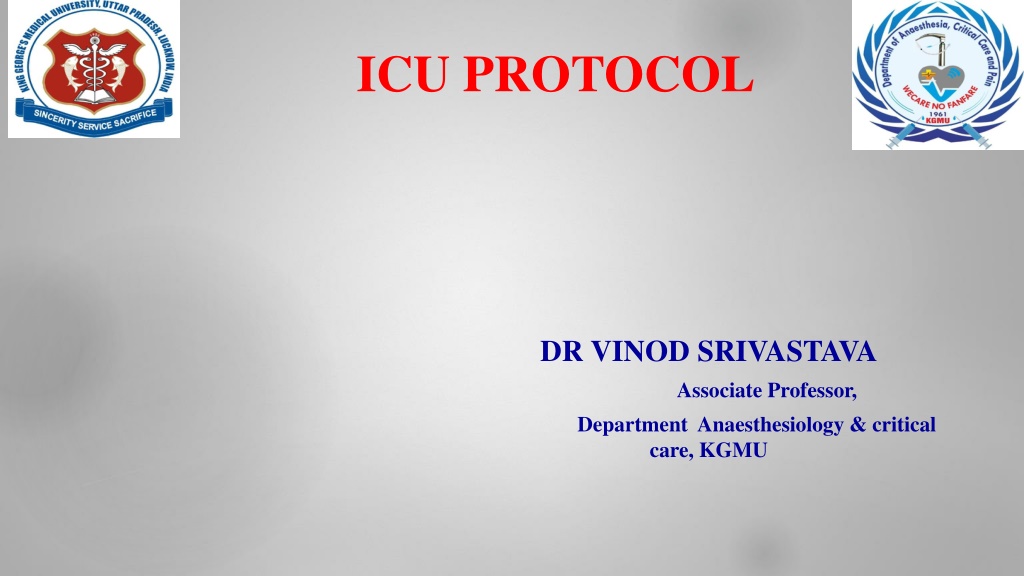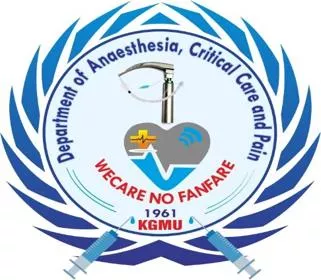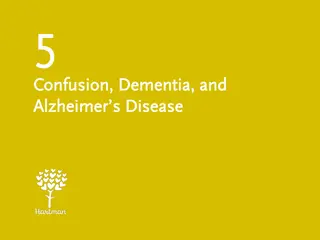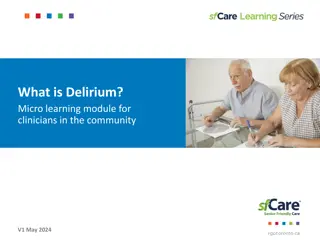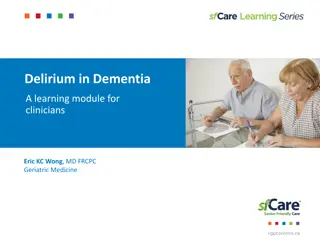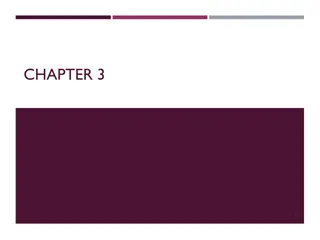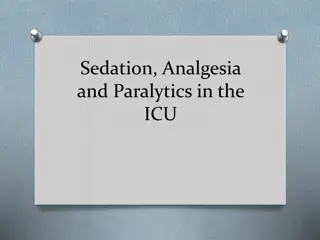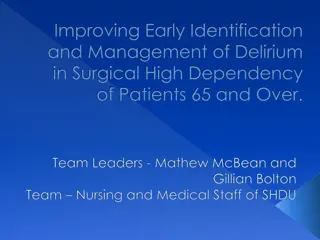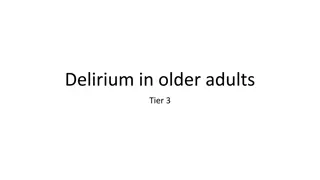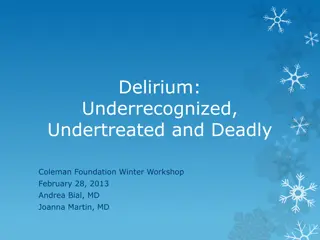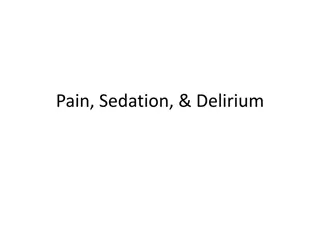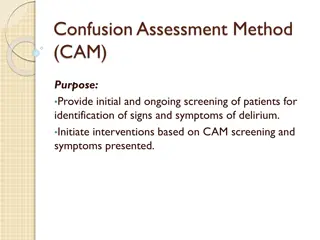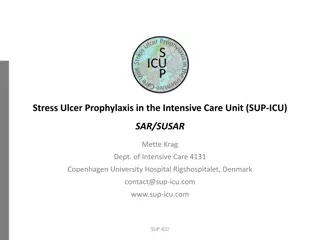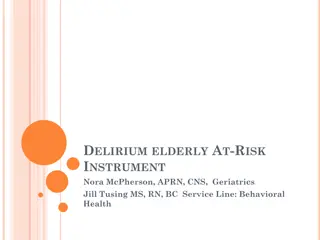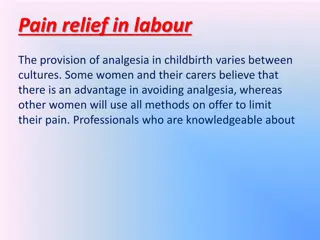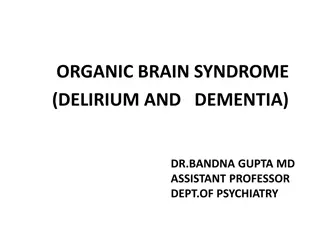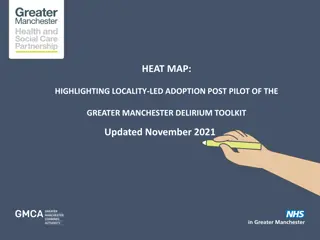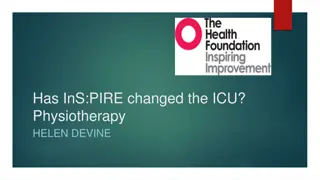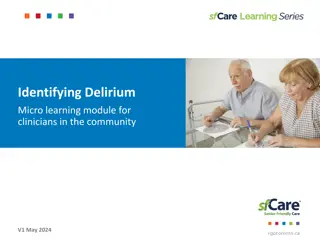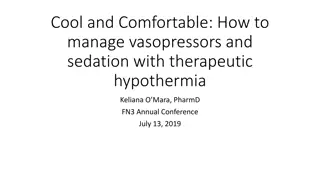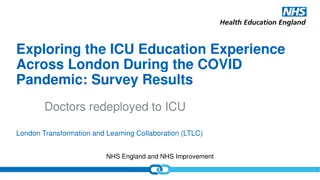Comprehensive ICU Protocol for Sedation, Analgesia, and Delirium Control by Dr. Vinod Srivastava
This comprehensive ICU protocol by Dr. Vinod Srivastava, an Associate Professor in Anaesthesiology & Critical Care at KGMU, covers key aspects such as sedation, analgesia, delirium assessment and control, stress ulcer and deep vein thrombosis prophylaxis, and glycaemic control in the ICU setting. The protocol emphasizes the importance of sedation and analgesia in promoting patient comfort, reducing anxiety, preventing pain and delirium, and aiding in ventilation and airway management. It also outlines protocols for pain, anxiety, delirium assessment, as well as guidelines for administering analgesia in ICU patients.
Download Presentation

Please find below an Image/Link to download the presentation.
The content on the website is provided AS IS for your information and personal use only. It may not be sold, licensed, or shared on other websites without obtaining consent from the author. Download presentation by click this link. If you encounter any issues during the download, it is possible that the publisher has removed the file from their server.
E N D
Presentation Transcript
ICU PROTOCOL DR VINOD SRIVASTAVA Associate Professor, Department Anaesthesiology & critical care, KGMU
Protocol Sedation and analgesia in ICU Delirium assessment and control in ICU Stress ulcer prophylaxis in ICU Deep vein thrombosis prophylaxis in ICU Glycaemic control in ICU
Sedation And Analgesia In ICU are 3c = calm, comfortable and Goal of sedation and analgesia cooperative Sedation are required for ICU patients to reduce anxiety and then consequently pain as well as delirium To facilitate mechanical ventilation/ airway management and weaning and any intervention combinedly need sedation and analgesia Decrease in anxiety leads to low incidence of delirium Amnesia during neuromuscular blockade
Analgesia protocol in ICU Pain: an unpleasant sensory or emotional experience. Cause of pain in ICU patients: Intubated patients, suction, invasive procedure, bronchoscopy, multiple sampling, trauma and post surgical etc. Describe in terms of intensity, duration, location and quality Intensity is determinant factor for need of analgesia Assesment : Subjective: (Self report) Objective (Behaviour observation) Vitals : heart rate, blood pressure and RR.
Subjective assessment Numerical ranking scale : valid and reliable assessment tool of conscious patient Score form 0-10
Objective assessment: Behavioural pain scale Valid and reliable assessment tool for intubated patients. Range from minimum 3 (no pain ) to worst pain (12)
General guidelines for Analgesia Analgesia is always given with sedation in ICU setting Analgesia is covered earlier before sedation of patient to reduce incidence of delirium Multi mode of analgesia can be used Types of analgesia : Intravenous :opioid and Non-opioids Regional anaesthesia: Central neuraxial or peripheral nerve block Transdermal patch
Scale used for assessment of sedation Richmond Agitation Sedation Scale (RASS)
Drugs used for sedation (A) Benzodiazepine group: Midazolam, lorazepam (B) Non-Benzodiazepine group: Propofol Ketamine Opioids Dexmedetomidine
Benzodiazepines DRUGS LOADING DOSE INFUSION REMARK 0.5 -4 mg 0.02-0.1 mg/kg/hour Liver metabolism Active metabolite through renal transmission Flumazenil antagonist Same as midazolam Propylene glycol toxicity with high dose infusion(hypotensi on,bradycardia,la ctic acidosis,) Midazolam 1-2 mg 0.01-0.1 mg/kg/hour Lorazepam
Non -Benzodiazepine LOADING DRUGS INFUSION REMARKS Propofol Not commonly used in ICU 1 mcg/kg over 10 minutes 5-50 mcg/kg/min For sedative purpose S/E propofol infusion syndrome Dexmedetomidine 0.2 to 0.7 mcg/kg/hour Used for sedation and analgesia Also anxiolytic Sedation and analgesia Helps in Bronchodilation S/E Increased secretion Ketamine 0.25 to 0.5 mg/kg bolus IV 0.05 to 0.4 mg/kg/hour 25 50 g 12.5 200 g/h Fentanyl Sedation and analgesia 2 4 mg 2-30 mg/hr Morphine Sedation and analgesia 15mg/kg in 15-20 min loading Paracetamol Analgesia anti-inflammatory
General Guidelines for sedation and analgesia Non benzodiazepine sedatives are preferred over benzodiazepine sedation to improve clinical 1. outcomes of ICU patient on mechanical ventilation. 2. Sedation andAgitation scale. Worst score to be recorded within the last 4 hours. Assess Patients at regular interval (every 4 hours) for sedation and agitation based on the 3. Titrate the infusion rate of sedative medication with the aim of keeping the patient calm and co- operative. 4. In patients with head injury in view of cerebral protection deep sedation is required. 5. Routinely in ICU the drugs used for sedation are midazolam and fentanyl. 6. Propofol is preferable for patients where neurological status is of concern, and patient is for early weaning.
7. Postoperative patients who require overnight ventilation may be give sedation and analgesia using: a. Fentanyl + propofol b. dexmedetomidine 8. Daily sedation vacation is given at a fixed time every morning. 9. If patients are agitated, look for alternative cause of agitation. Communicate with patients, assure and increase the sedative dose if required. 10. Titrate the infusion rate according to sedation score at frequent interval by assessing the patient s sedation score regularly. 11. Opioids and sedatives have a synergistic action. Lower doses of sedatives should be used if opioids or other sedatives are used.
Delirium In ICU Delirium is an acute confusion state that is caused by direct physiological effects of some medical disease conditions, use of any psychoactive substances that develop over the course of hours and day. In ICU delirium is non specific, preventable and reversible Clinical syndrome: Common: Attention disorder Lack of awareness Cognitive impairment Uncommon : Altered psychomotor activity Disturbed circadian rhythm Emotional disturbance and Perception disorder like hallucination and delusion.
Etiology Multifactorial . Predisposing and precipitating factor Interaction of these two causes delirium Predisposing Factor:: Nonmodifiable Elderly patients (> 65 years) Preexisting Cognitive impairment/dementia Associated comorbidity like hearts disease, cerebrovascular disease, and cancer Psychiatric morbidity (e.g., depression, bipolar disorder) Sensory impairment (i.e., vision and hearing)
Precipitating factor: Modifiable Medication (benzodiazepine, opioids, anticholinergic steroid) Stroke, meningitis Infection (e.g., URTI, UTI) Sleep deprivation Hospital environment (dim light, noise in ward, unfamiliar person) Emotional stress Constipation /urinary retention Hypoxia, hypercarbia and anemia Alcohol withdrawal Dehydration/malnutrition Major surgery (cardiac, vascular Inadequate analgesia surgery
Screening of Delirium Two tools are used: Intensive care delirium screening checklist (ICDSC) Confusion assessment method for ICU (CAM-ICU)
Intensive care delirium screening checklist (ICDSC) It is assessed by 8 parameter: Each parameter is scored 0 to 1. Maximum score is 8 and minimum is zero. Altered level of consciousness (1) Inattention (2) Score of 4 is considered having delirium. Disorientation (3) Sensitivity of 99% and specificity of 64%. Hallucination, delusion or psychosis (4) Not a good tool for stupor or comatose patient. Inappropriate mood or speech (5) Psychomotor agitation or retardation (6) Sleep wake cycle disturbance (7) Fluctuations (8)
Confusion assessment method for ICU (CAM-ICU) Most common and reliable method in ICU 4 Important features are key points for diagnosis of delirium. Feature 1:Acute Onset or Fluctuating Course Feature 2: Inattention Feature 3:Altered Level of Consciousness Feature 4: Disorganized Thinking
Treatment Stop and THINK Stop all medication if patient having that can precipitate like anticholinergic, corticosteroid, benzodiazepine, opioids etc. THINK: T= treat the toxic situation like CHF, Shock, dehydration, H= treat for hypoxia, hypercarbia I= treat infection and avoid immobilize (early mobilization) N= non-pharmacological intervention K= k+ or electrolyte correction
Non-Pharmacologic Family interaction with patients. Noise Reduction by use of earplugs for patients at night, reduce alarm volume. Familiar belongings near the patient. Adequate light in ICU ward. Improving sleep by sedation. Communicate with patients and covey Reduce interruption at night. date, place and reason for hospitalization. Optimize bladder and bowel function. Avoid any type of stress.
Pharmacological Haloperidol: short term use of low dose haloperidol at least for a week i Atypical antipsychotics: use of this medication may reduce the duration of delirium (eg. risperidone, olanzapine, ziprasidone, and quetiapine ) The antidepressant trazodone is sometimes used for the same but effect should be weighed against its sedation side effect. Dexmedetomidine should be practiced for sedation in place of benzodiazepine to reduce delirium.
Stress Ulcer Prophylaxis Stress ulcer=Stress related mucosal disease (SRMD). Ulceration of gastric mucosa of upper gastrointestinal (GI) tract due to hospitalization. Ranges from common superficial mucosal injury, occult GI bleed, Hematemesis, to severe upper GI bleeding causing hemodynamic instability. Mechanism : two mechanism responsible for 1. there are increased acid secretion 2. disruption of glycoprotein mucous layer
Risk factor for stress ulcer: patient with 2 are at greater risk 6. syndrome (MODS). Multi organ dysfunction 1.Prolonged ventilation hours. mechanical more than for 48 7.Acute kidney injury. 2. Coagulation disturbance. 8. Liver Failure. 3. Shock. 9.History ulcers. of gastrointestinal 4. Severe traumatic brain injury. 10.Glucocorticoid therapy. 5. Burn > 30%.
Drugs used for prophylaxis Proton pump inhibitor: IV pantoprazole 40mg OD H2 antagonist : Ranitidine 50 mg IV 8 hourly Oral sucralfate: 1 gm every 6 hours
General guidelines for SMRD prophylaxis Stop prophylactic therapy if patients does not have upper GI bleeding. Switch over to oral medication as soon as patients start accepting oral feeding. Those patients who develop clinically significant bleeding continue proton pump inhibitors for at least 2 weeks Combination of prophylactic therapy along with enteral nutrition has been shown to reduce SRMD incidence.
Deep Venous Thrombosis Prophylaxis DVT: Blood clot in deep vein Most prevalent in critically ill patients most commonly involved vein are pelvic ,thigh and leg and less commonly in arm
Sign and symptoms The common symptoms are Swelling Erythema Pain in affected part of body Long standing complication are Ulceration The most life threatening complication is Pulmonary embolism
Pathophysiology of DVT Virchow s triad: three involved mechanism are 1. Decreased blood flow (venous stasis) 2. Endothelial injury 3. Hypercoagulability of blood
Risk factor for DVT Trauma and long bone fracture Old age Pregnancy and postpartum Prolonged immobilization Obesity Major surgery Elevated CVP due to heart failure Previous DVT Coagulation Polycythemia, thrombocytosis disorders e.g., Malignancy Hormonal replacement therapy
DVT prophylaxis: General guidelines Every patient in ICU should be assessed for requirement of DVT prophylaxis. Non-pharmacological (mechanical) and pharmacological methods used as prophylactic. Early ambulation is most crucial non pharmacologic method for prevention of VTE. There is no advantage of combined pharmacologic and mechanical prophylaxis over pharmacological prophylaxis alone. Thromboprophylaxis should be reviewed daily and changed accordingly. Thromboprophylaxis should be continued even after transfer from ICU till the risk of DVT is over.
Methods for Prophylaxis 1. Mechanical prophylaxis: In patients of high risk bleeding such as post surgical, neurological, hemorrhagic and bleeding disorder a. Graduated compression stockings. b. Intermittent pneumatic compression. 1. Pharmacological prophylaxis: a. Unfractionated heparin. b. Low Molecular Weight Heparin (LMWH) c. Fondaparinux.
Graduated compression stocking (anti- embolic stockings) Greatest degree of pressure at the ankle and gradually decreases when goes upwards (graduated compression) Prevents backflow Avoid in peripheral neuropathy, allergy to material, local soft tissue infection, improper size.
Intermittent pneumatic compression Inflatable sleeves attach through a air pump Inflate every 20-60 seconds then deflate, starting at ankle and goes upward act as leg massage More effective than GCS
Pharmacological prophylaxis It should be started as soon as possible if not contraindicated. Started once risk of bleeding is excluded after 24-72 hours depending upon the surgery and hemostasis achieved. Unfractionated or Low Molecular Weight Heparin (LMWH) should be avoided in patients with platelet counts less than 1,00,000/L or INR >1.5. LMWH should be stopped 12 hours before removal of epidural catheter and can be restarted only after 2 hours after removing it.
LMWH preferred to unfractionated heparin Once daily dosing, Enhanced bioavailability, Minimal incidence of heparin-induced thrombocytopenia Cost benefit No requirement for laboratory monitoring.
Recommended dose of anticoagulant as prophylaxis UFH- 5000 units SC 8-12 hourly Enoxaparin- 30 mg 12-24 hourly or 40 mg once a day SC Daltaparin 5000-10000 units 12 hourly SC Fondaparinux 5-10 mg daily SC
Asses for risk of DVT Yes Risk of bleeding Yes No Mechanical Pharmacological Prophylaxis Prophylaxis HIT? Intermittent Pneumatic compression device No Yes Unfractionated heparin and LMWH Heparinoids: Fondaaparinux Graded compression stockings
Glycemic control in ICU Hyperglycemia is strongly associated with increased mortality as well as organ system dysfunction among critically ill patients Goal: Maintain the glucose level 140-180 mg/dl. But hypoglycaemia and intensive glycaemic control were associated with adverse outcomes
Why hperglycemia in critically ill patients Increased counter regulatory hormones (glucagon ,cortisol) Insulin resistance Decrease insulin stimulated uptake of glucose in tissue Glucocorticoid therapy Dextrose containing solution and TPN
Monitoring in ICU Blood testing by finger testing Diet Frequency of monitoring NPO 8 hourly PO 1 hour before feed and 6 hourly TPN 6 hourly . 6 Am, noon, 6PM,midnight
Treatment of hyperglycemia Glucose level (mg/dl) Action (subcutaneous insulin dose) <140 No treatment 140-169 3 unit of regular insulin, recheck after 3 hour 170-199 4 unit of regular insulin, recheck after 3 hour 200-249 6 unit of regular insulin, recheck after 3 hour 250-299 8 unit of regular insulin, recheck after 3 hour >300 10 unit of regular insulin, recheck after 3 hour
Insulin infusion If glucose value excceds 200 on two measurement, a continuous insulin infusion started. Must receive continuous source of glucose either D5 or TPN, enteric feed Hourly glucose charting Glucose value (mg/dl) 200-249 Insulin dose 4 U/hour 250-299 6 U/hour 300-399 8 U/hour 400 10 U/hour
Subsequent management Glucose value (mg/dl) Action (Insulin dose ) <140 Stop infusion 140-169 2 Unit/hour 170-199 3 Unit/hour 200-349 6 Unit/hour 350-399 8 Unit/hour 400 10 Unit/hour
